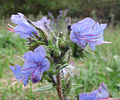| Viper's bugloss | |
|---|---|
 | |
| Scientific classification | |
| Kingdom: | Plantae |
| Clade: | Tracheophytes |
| Clade: | Angiosperms |
| Clade: | Eudicots |
| Clade: | Asterids |
| Order: | Boraginales |
| Family: | Boraginaceae |
| Genus: | Echium |
| Species: | E. vulgare |
| Binomial name | |
| Echium vulgare | |
Echium vulgare, known as viper's bugloss and blueweed, [1] is a species of flowering plant in the borage family Boraginaceae. It is native to most of Europe and western and central Asia [2] [3] and it occurs as an introduced species in north-eastern North America, south-western South America and the South and North Island of New Zealand. [1] [4] If eaten, the plant is toxic to horses and cattle through the accumulation of pyrrolizidine alkaloids in the liver. [5] [6]
Contents
The plant root was used in ancient times as a treatment for snake or viper bites. [7] [8] According to the Doctrine of signatures, plants were thought to have traits (in this case a speckled stem reminiscent of snake skin, and flowers like an open viper's mouth) that mirror the ailment they treat. [9] [10]





